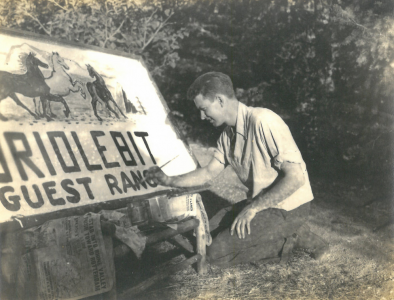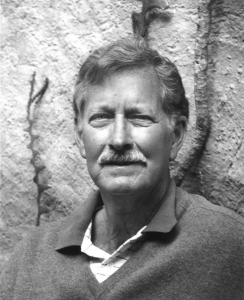

Biography
Kennet Evett was born in Loveland, Colorado, one of three sons of Charles Evett, who operated a livery stable in Estes Park. All three sons ended up with careers in the arts or academia, his older brother a college teacher of English, and his younger brother a composer and editor. As a teenager, Kenneth showed some of his drawings to Thomas Hart Benton, who was in Colorado visiting an Estes Park neighbor. Benton was sufficiently impressed to recommend the young Evett for a scholarship to the Fine Arts Center in Colorado Springs, a newly founded institute that rapidly became a breeding ground for many Colorado artists. After a foray into public school teaching, Evett obtained commissions for several New Deal Post Offices. Early in World War II he worked as a welder and had a brief flirtation with the Communist Party. Later he taught in North Carolina and Virginia before a lucky break at the Kraushaar Gallery in New York. Antoinette Kraushaar had been Evett's dealer, and he was visiting her when she received an inquiry from Cornell University about candidates for a possible fill-in position. This was Evett's springboard to an academic career of over three decades.Professor Evett became a dedicated member of the Cornell faculty, not only influencing the careers of hundreds of artists, but becoming active in the community and even cheering on Cornell's athletic teams. Over time he had a dozen one-man shows at the Kraushaar Gallery, and participated in group shows at major museums around the country. In 1954 he won a national competition to produce murals for the rotunda of the State Capitol in Lincoln, Nebraska. In the 1960s he began to focus on watercolors, preferring to paint in nature with no initial sketches. The hundreds of watercolors that he produced in this manner are perhaps his greatest artistic legacy.



Critical Analysis
Evett's style in the 1930s was largely representational, but it involved a dense interplay of figures and a preponderance of deep colors. By the time of his Nebraska mural, he was experimenting with elements of cubism, a fact not lost on the Nebraska Legislature, and almost enough to torpedo his contract. Evett stayed above the political fray, painting the murals in a studio in Rome, where he had traveled for a sabbatical year, using the funds obtained from his mural contract. He was well-aware that the McCarthy years of the 1950s were a poor time to wage a major battle over art, especially for someone who had once been a Party member himself. His opponents grew tired of their own invective, and the murals grace the state Capitol Rotunda to this day.Evett's favored medium shifted from oils to Sumi ink to drawings and eventually to watercolors. Evett prided himself on the spontaneity of his watercolors. He and his wife would drive about the countryside - wherever they happened to be - until they found a suitable place, where he would set up his easel, eye his surroundings for a bit of dramatic inspiration, and begin to paint. He said that the first brush-stroke was the most important, and he would use it to define a point of emphasis in his painting. What's striking about his watercolor work, as it evolved over time, is the brilliance and depth of his colors. He is able to achieve in this medium the same intensity - if not more - than he brought to his early oil paintings. They shine with a strong sense of place and a brilliant eye for light.
Murals
- Golden, Colorado - Downtown Post Office: Building the New Road
- Caldwell, Kansas - Post Office: Cowboys Driving Cattle
- Horton, Kansas - Post Office: Changing Horses for the Pony Express
- Horton, Kansas - Post Office: Picnic in Kansas
- Lincoln, Nebraska - State Capitol Rotunda: Laboring in Nebraska
- Pawnee City, Nebraska - Post Office: The Auction
References
- Kenneth Evett (Kenneth Evett).
- Kenneth Evett (askART).
- Kenneth Warnock Evett (1913-2005) (David Cook Galleries).
- Laboring in Nebraska (Nebraska Virtual Capitol). Evett murals in the Rotunda of the State Capitol in Lincoln, Nebraska
- Noted watercolorist and Cornell art professor Kenneth Evett dies at 91, Cornell Chronicle June 3 (2005).
- Michael Kammen, Visual Shock: A History of Art Controversies in American Culture. Vintage , New York (2007).